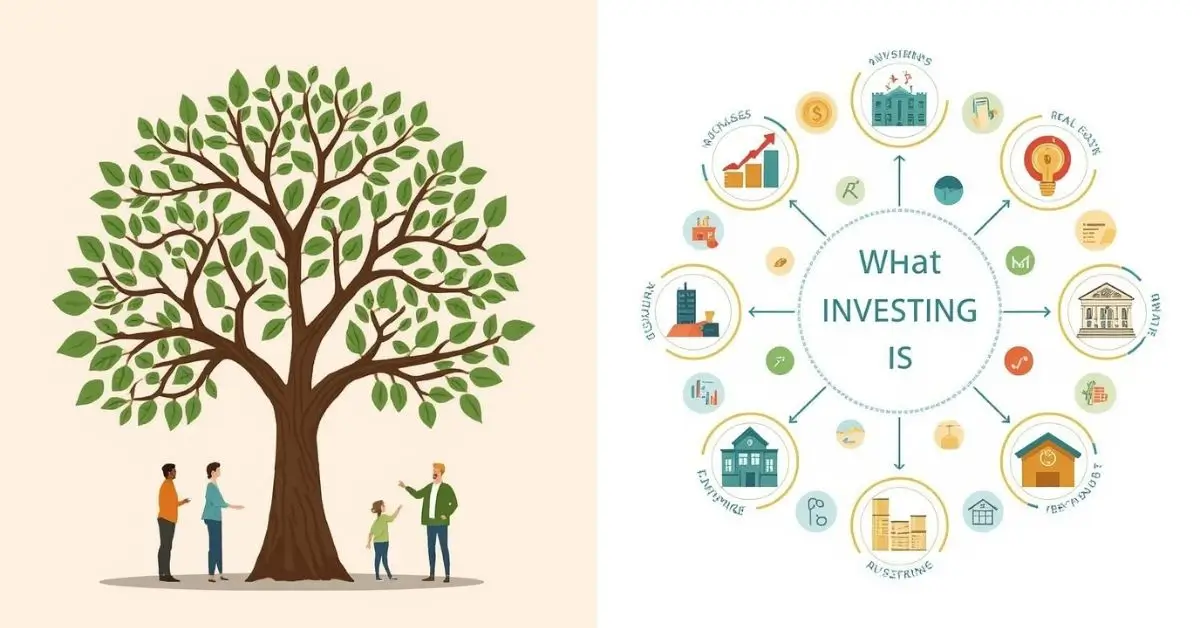If you’ve ever wondered what investing is and how it could change your financial future, you’re not alone. Many beginners, students, professionals, and even small business owners feel overwhelmed by the world of investing. It seems complex, risky, and full of jargon—but at its core, investing is about putting your money to work so it can grow over time.
This guide breaks down the investing definition, explores the basics of investing, and explains why it matters for everyday savers, retirement planners, and entrepreneurs. By the end, you’ll understand what investing is and how it works, along with clear examples and strategies to get started.
What Investing Is: The Simple Definition
At its most basic, investing means allocating money or resources today with the expectation of earning a return in the future.
- Saving: setting aside money for safety.
- Investing: using money to buy assets that can grow or generate income.
In short, investing is a tool for wealth building, while saving is more about preservation.
What Investing Means in Simple Terms
For beginners:
- You buy something valuable (stocks, real estate, bonds, etc.).
- That asset either grows in value or pays you income (dividends, rent, interest).
- Over time, your money multiplies without you having to work harder.
Think of it like planting a tree: the earlier you plant, the more shade and fruit you’ll enjoy later.
The Basics of Investing for Beginners
Understanding the basics of investing helps remove the fear and uncertainty.
Key Concepts
- Risk and reward in investing: higher returns usually mean higher risks.
- Compound interest: your money earns interest, and that interest earns more interest.
- Diversification: spreading investments across assets to reduce risk.
\Step-by-step guide on what investing is:
- Define your goals (retirement, education, business growth).
- Decide your risk tolerance.
- Learn about different types of investments.
- Start small and grow steadily.
Types of Investments You Should Know
There are many ways to invest, each with different purposes.
| Type of Investment | Description | Example | Risk Level |
|---|---|---|---|
| Stocks | Ownership in companies | Apple, Tesla | Medium–High |
| Bonds | Lending money to governments/companies | U.S. Treasury Bonds | Low–Medium |
| Real Estate | Property for rental or resale | Rental apartments | Medium |
| Mutual Funds/ETFs | Pooled investment funds | S&P 500 ETF | Low–Medium |
| Small Business | Building or buying a company | Local café | Hig |
- It helps you beat inflation (savings lose value over time).
- It builds long-term financial growth.
- It creates income streams for retirement.
- It offers a path to financial independence.
As the U.S. Securities and Exchange Commission (SEC) emphasizes, investing is critical to meeting future financial needs.
Investing vs. Saving Money
- Saving: short-term, safe, limited growth.
- Investing: long-term, riskier, higher potential growth.
If your money only sits in a savings account, inflation may reduce its value over time. Investing helps counter this.
What Investing Is in the Stock Market
Stock market investing means buying shares of companies with the goal of earning returns through:
- Capital appreciation (stock prices rising).
- Dividends (profit sharing).
This is the most common path for beginners.
What Investing Is Compared to Trading
- Investing: long-term strategy, patient growth.
- Trading: short-term buying and selling for quick profits.
Investors focus on time in the market, while traders focus on timing the market.
What Investing Is in Real Estate
Real estate is another powerful way to build wealth:
- Rental income provides cash flow.
- Property value growth builds long-term equity.
According to the National Association of Realtors, real estate remains one of the most popular investment vehicles for stability and returns.
What Investing Is with Compound Interest
Compound interest is often called the “eighth wonder of the world.”
Example:
- Invest $1,000 at 8% annual return.
- In 30 years, it grows to over $10,000 without adding more money.
This is why starting early is key.
Best Beginner Strategies for Investing
If you’re just learning what investing is for beginners, start simple:
- Index funds or ETFs – low-cost, diversified, beginner-friendly.
- Automatic contributions – invest a fixed amount monthly.
- Employer retirement accounts – like 401(k) or IRA contributions.
According to Vanguard Research, passive investing through index funds is one of the most effective beginner strategies.
How to Start Investing with Little Money
You don’t need thousands of dollars. Today, apps and brokers allow you to start with as little as $5–$10.
Tips:
- Use fractional shares.
- Automate small weekly deposits.
- Focus on consistency, not timing.
Educators: How to Explain Investing to Kids
When explaining to children:
- Compare investing to planting seeds.
- Show them how money “grows” over time.
- Use small piggy bank examples.
This makes financial literacy approachable.
References
- U.S. Securities and Exchange Commission (SEC) – Beginner’s Guide to Investing
- Vanguard Research – Index funds and passive investing strategies
- National Association of Realtors – Real estate investment insights
FAQs About What Investing Is
What investing is and how it works?
Investing works by using money to buy assets that grow in value or generate income over time.
What investing means in simple terms?
It means putting your money to work so it can grow instead of sitting idle.
What investing is for beginners?
For beginners, it’s buying safe, diversified assets like ETFs or mutual funds.
What investing is and why it’s important?
It’s important because it builds wealth, beats inflation, and supports future goals.
What investing is vs saving money?
Saving preserves money, investing grows it.
What investing is in the stock market?
It’s owning company shares that can rise in value or pay dividends.
What investing is compared to trading?
Investing is long-term, trading is short-term speculation.
What investing is with examples?
Examples include buying stocks, bonds, property, or mutual funds.
What investing is in real estate?
It’s purchasing property for income or long-term appreciation.
What investing is with compound interest?
It’s reinvesting returns so your money multiplies over time.
What investing is and best beginner strategies?
Start with index funds, diversify, and automate contributions.
How to explain what investing is to kids?
Use simple examples like planting seeds or saving coins.
Step-by-step guide on what investing is?
Define goals, learn basics, choose investments, start small, and grow.
What investing is and how to start with little money?
Use low-cost apps, buy fractional shares, and invest consistently.
Conclusion
Understanding what investing is gives you the foundation to build wealth, achieve financial goals, and create long-term security. With the right knowledge and a thoughtful strategy, anyone—from beginners to experienced savers—can make smart choices that turn today’s money into tomorrow’s opportunities.
Liam is a freelance writer, blogger, and digital media journalist. He has a management degree in Supply Chain & Operations Management and Marketing and boasts a wide-ranging background in digital media.











